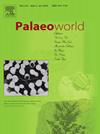巢中的陌生人:关于巴西南部(坎德拉利亚序列,上三叠世)新记录的犬齿反齿龙的生物地层学意义
IF 1.7
3区 地球科学
Q2 PALEONTOLOGY
引用次数: 0
摘要
Várzea do Agudo 是巴西南部坎德拉里亚序列的一个上三叠世遗址,拥有丰富的化石记录。它之所以被归入AZ亚区(卡年中晚期),主要是因为该地点迄今为止发现的唯一一种倒齿龙。在本研究中,我们报告了在 Várzea do Agudo 遗址首次发现的倒齿龙。新标本出土于露头的上层。眶间凹陷发育不良、颌下突不明显、羊齿嵴基部凹陷不深、上后齿的远端附属唇尖比......更偏向唇侧以及两颗上门齿等诊断特征证实了它是......,到目前为止,这是该物种在倒齿龙类中的一个同形特征。......模式产地的年代一直是一个争论的话题。虽然......的产地与比AZ......的产地更年轻的地层有关,但由于缺乏指数化石,因此无法采用适当的生物地层学方法。在.与.的同一地点发现.标本,对阿古多市出露化石的生物地层学提出了挑战。不过,值得注意的是,新标本是在出土......的地层之上挖掘出来的。这就提出了一个问题,即 Várzea do Agudo 遗址的化石地层是在一个事件中或一个短时期内沉积的,还是反映了两个不同的时间层。如果是后者,那么在含化石的遗址附近存在着具有独特动物组成的早纪遗址,这可能意味着在这一AZ和AZ亚区之间存在着一个中间动物群,而......将是其中的一个组成部分。考虑到这一背景,本研究讨论了新记录对坎德拉利亚序列遗址生物地层学可能产生的影响。本文章由计算机程序翻译,如有差异,请以英文原文为准。
On the biostratigraphic relevance of a new record of a traversodontid cynodont in southern Brazil (Candelária Sequence, Upper Triassic)
The Várzea do Agudo is an Upper Triassic site of the Candelária Sequence of Southern Brazil that boasts an extensive fossil record. It is assigned to the Exaeretodon subzone of the Hyperodapedon Assemblage Zone (AZ) (mid-late Carnian) mainly due to the prevalent presence of the traversodontid Exaeretodon riograndensis — up to now the sole traversodontid discovered at the site. In this study, we report the first record of the traversodontid Siriusgnathus niemeyerorum in the Várzea do Agudo site. The new specimen was excavated from the upper layers of the outcrop. Its identification as S. niemeyerorum is substantiated by diagnostic features such as a poorly developed interorbital depression, an inconspicuous suborbital process of the jugal, a not deeply concave base of the lambdoidal crest, the distal accessory labial cusp of the upper postcanines more labially oriented than E. riograndensis, and two upper incisors — so far, a trait autapomorphic to the species among traversodontids. The age of the type locality of S. niemeyerorum has been a subject of debate. Whereas the Siriusgnathus-bearing sites had been associated with younger levels than those of the Hyperodapedon AZ, the absence of index fossils hampered proper biostratigraphic approaches. The finding of a S. niemeyerorum specimen in the same site as E. riograndensis poses a challenging scenario for the biostratigraphy of the fossiliferous outcrops of the municipality of Agudo. It is noteworthy, however, that the new specimen was excavated above the layers yielding E. riograndensis. This raises the question of whether the fossiliferous stratum of the Várzea do Agudo site was deposited in a single event or in a short period, or if it reflects two different time horizons. In the case of the latter, the existence of early Norian sites with distinct faunal composition near the Siriusgnathus-bearing sites could imply the existence of an intermediate fauna between this AZ and the Exaeretodon subzone of the Hyperodapedon AZ, of which S. niemeyerorum would be a constituent. Considering this context, this study discusses the possible biostratigraphic implications of the new record for the biostratigraphy of the sites of the Candelária Sequence.
求助全文
通过发布文献求助,成功后即可免费获取论文全文。
去求助
来源期刊

Palaeoworld
PALEONTOLOGY-
CiteScore
4.00
自引率
5.90%
发文量
95
期刊介绍:
Palaeoworld is a peer-reviewed quarterly journal dedicated to the study of past life and its environment. We encourage submission of original manuscripts on all aspects of palaeontology and stratigraphy, comparisons of regional and global data in time and space, and results generated by interdisciplinary investigations in related fields. Some issues will be devoted entirely to a special theme whereas others will be composed of contributed articles. Palaeoworld is dedicated to serving a broad spectrum of geoscientists and palaeobiologists as well as serving as a resource for students in fields as diverse as palaeobiology, evolutionary biology, taxonomy and phylogeny, geobiology, historical geology, and palaeoenvironment.
Palaeoworld publishes original articles in the following areas:
•Phylogeny and taxonomic studies of all fossil groups
•Biostratigraphy, chemostratigraphy, chronostratigraphy
•Palaeoecology, palaeoenvironment and global changes throughout Earth history
•Tempo and mode of biological evolution
•Biological events in Earth history (e.g., extinctions, radiations)
•Ecosystem evolution
•Geobiology and molecular palaeobiology
•Palaeontological and stratigraphic methods
•Interdisciplinary studies focusing on fossils and strata
 求助内容:
求助内容: 应助结果提醒方式:
应助结果提醒方式:


